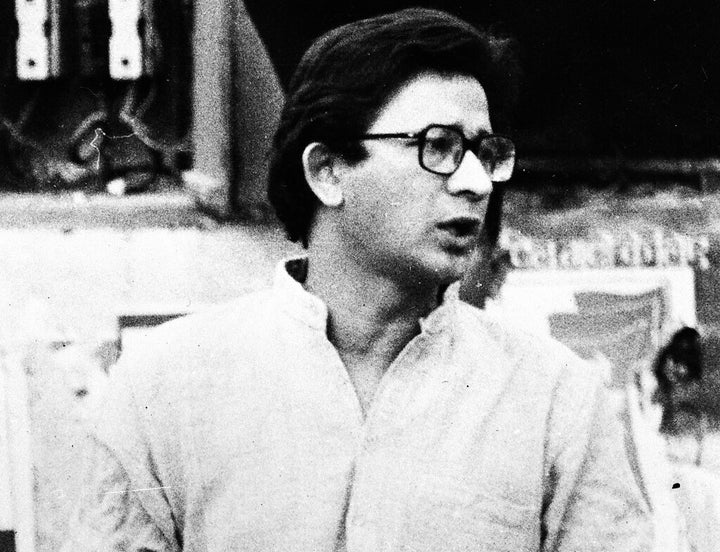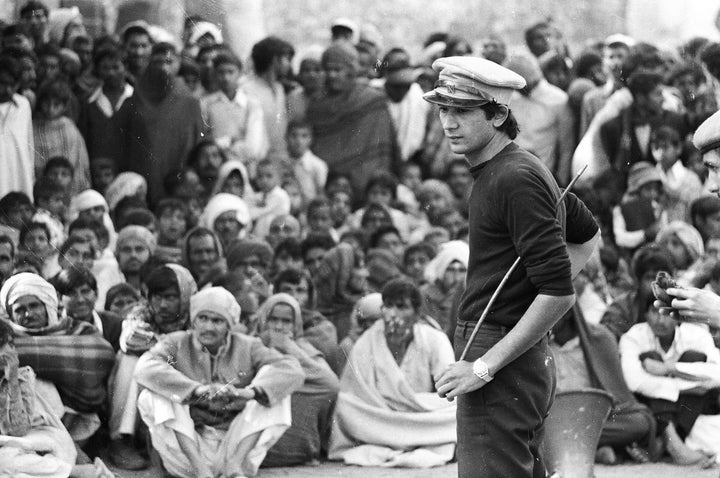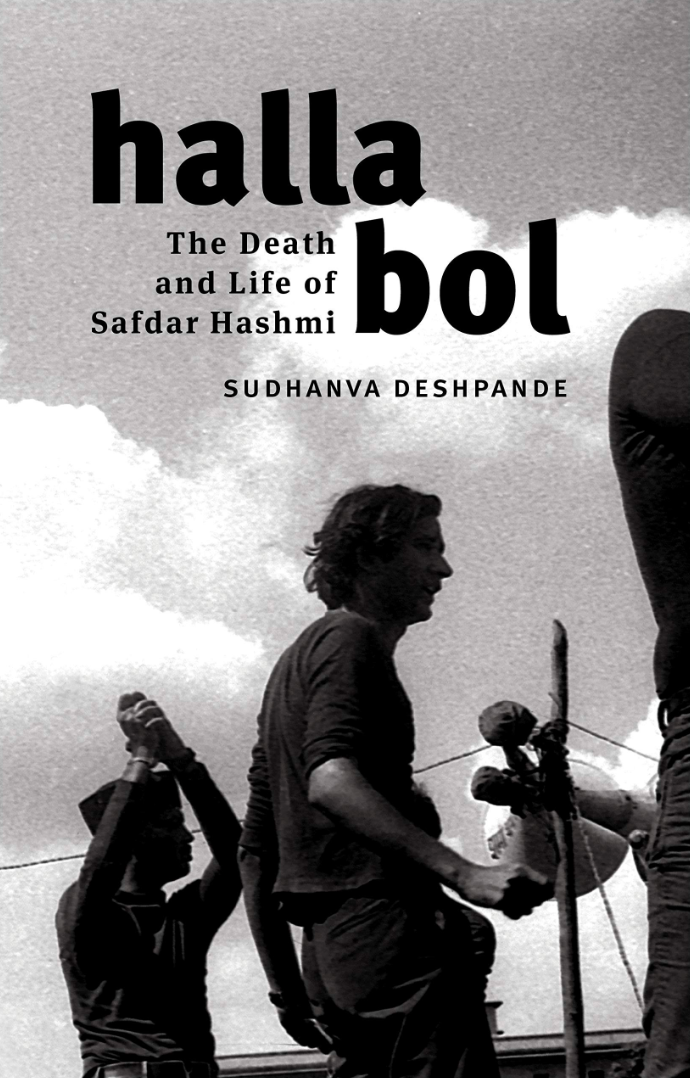
I had worked as a journalist for nearly six years, and been vaguely interested in theatre and performance for longer than that, before I heard the name ‘Safdar’. I had actually heard of SAHMAT first, because the Safdar Hashmi Memorial Trust organised a cultural programme on the first day of every year. It wasn’t until I attended one such programme that I learnt about the murder of a young writer, organiser and director called Safdar Hashmi in 1989, while he was performing a street play with a group of young actors in Jhandapur, on the fringes of Delhi.
Over the next 15 years, I picked up more scraps of information, by meeting some of Safdar’s friends and watching a documentary film about the theatre group Jana Natya Manch, better known as Janam. I learnt that 34-year-old Safdar was assaulted in broad daylight, later dying of his injuries, and that the group of actors, led by his wife Moloyashree, went back to complete the play in the same location just two days after he died.
Knowing these bald facts did little to prepare me for the viscous crush of detail, the awfulness of a fuller understanding of what happened on the morning of January 1, 1989. Through Halla Bol: The Death and Life of Safdar Hashmi, his colleague and friend Sudhanva Deshpande has brought to painful life the gentleness, good cheer, wide sweep of affection, and especial mix of talent, camaraderie and commitment to human values that Safdar was made of. Making his acquaintance 30 years after he died, I found myself having to put the book away more than once, overcome by the knowledge of what was done to him.

Safdar was born to Qamar Azad Hashmi and Haneef Hashmi in 1954. With a school teacher mother, and a Leftist father who ran a furniture workshop in Aligarh before working with a Russian news agency in Delhi, there was little money to spare, but the family subscribed to Urdu literary magazines and invested in culture whenever possible. As Deshpande tells it, Hashmi’s father, known to everyone as ‘Abbuji’, had bought a radio with his first salary… “and his second salary went towards a record player and three LPs – one of K.L. Saigal; one of Pankaj Mullick; and the third, of Pandit Ravi Shankar’s ten short pieces.”
Going to the cinema was a rare event but poetry was, quite literally, in the household air and the children picked up Ghalib and Mir.
Educated at the New Delhi Municipal School, the DAV school and later the Delhi Kannada Senior Secondary School, Safdar spoke very little English when he joined the elite St Stephen’s College. But it didn’t take him long to learn the language, or to get involved with Indian People’s Theatre Association (IPTA), a theatre group that had been active since the 1940s and was the crucible from which generations of performers emerged. However, there was a split in artistic vision, which was perhaps inevitable after the splitting of the Communist Party of India in 1964.
His older brother Sohail had already joined the students’ group, Students’ Federation of India, affiliated with the Communist Party of India (Marxist). Safdar was part of a restless faction that wanted IPTA to “perform more and more for the working class and farmers” and therefore, proposed to break away and set up a new group. As it turned out, this group was evicted “in dramatic fashion”, with their materials being thrown off from the first floor onto the street. So it was that, in 1973, 19-year-old Safdar and his friends banded together and formed a new group, Janam. Over the next decade-and-a-half, Safdar had written a clutch of powerful scripts and was working to enhance the skills of all the actors associated with the group through a series of workshops, when he was killed.
In Deshpande’s telling, the day unfolds with foreboding, then horror, and magical touches of mercy and courage. Safdar was beaten and left for dead; a migrant worker called Ram Bahadur was shot for no ostensible reason other than the attackers’ need to send shockwaves of violence and terror through the neighbourhood. Students and actors ran through an unfamiliar maze of ramshackle homes, their lives saved by residents who shielded them at some risk to themselves.
The tragedy swells and gains sharp angles as we discover details that do not at first appear to be violent per se. Not only did the police not show up to help, they arrested a man who managed to run all the way to the police station to inform them. No ambulances showed up either. Safdar, still alive, had to be transported first on a hand cart, then a cab, then a car, and then moved from hospital to hospital in search of one that had the requisite equipment and expertise. Embedded in the story of an artiste’s brutal murder is the story of structural violence – of neighbourhoods that have no decent hospitals, of major public hospitals that lack the equipment to deal with trauma injuries, of morbid and moribund procedure that does not allow people to get the medical care they need in an emergency unless it is registered as a ‘case’ by the police, of a dysfunctional and even criminal police force.
Other kinds of structural violence were the basis for the work that Safdar did with Janam, and also in his writings elsewhere. Most of us who grew up in the 1980s and 90s, especially those who understand Hindi and had access to television, will be familiar with the song ‘Padhna likhna seekho, o mehnat karne walon’. Without knowing who wrote it, millions may have imbibed a little of its gentle stress on education as a tool to attain justice, and the need to fight for it.

The intimacy and obvious affection of the author/narrator’s voice make Safdar’s charm and tenderness palpable, as also his uncluttered focus on theatre. It was through theatre that he met his future wife and colleague Mala (Moloyashree), although it took several turns of fate for them to look at each other with eyes of love. Readers are sure to be delighted by the story of Safdar’s failed attempt to change his surname after they were married.
Deshpande’s account is moving and straightforward by turns. Adding flesh and colour to the portrait are passages describing the creative choices that shaped each major play, the networks of talent that fed into Janam, the web of friendships that served as its scaffolding. Actors and writers will take particular delight in the details of how a particular text was fine-tuned, or how a show was salvaged from potential disaster.
The only quibble I have is that where minimum wages at factories around Delhi in the 1980s are discussed, it isn’t specified that these are monthly wages, and not daily or weekly, a detail that might have been useful for contemporary readers. It might also have helped if a few passages had explored the overlap of Safdar’s work for the CPI(M), and the sort of organisational labour full-time theatre requires.
The book does interweave personal anecdotes with the economic and political context for the kind of theatre Janam was doing. There are references to groups that were doing comparable work in other parts of the country, as well as passages reflecting upon whether there’s any point to it—the hard, unremunerative work of organising and performing with a view to effecting change.
As the author points out, workers do not need to be told that they are exploited, and he poses the question: ‘What can theatre do, then?’
He does not make the case that education, or theatre, can usher in major changes in the short term. What it can do is strengthen the belief, at least among a few people, that change is possible. This book can also be read, then, as a document of beleaguered hope and faith.
Deshpande writes, “Safdar died a hero, and his heroism was magnified by the creativity of thousands of artists and intellectuals who came together in his name to create a secular counternarrative to the religious right.”
In the decades since, Janam has continued to perform. Writers and thinkers have struggled to counter the rising crescendo of misinformation, ahistoricity and divisive political rhetoric, even though their voices are often drowned out, or violently snuffed out.
The point is not that Safdar died but that he lived, and that he dreamed, among other things, of a performance space that was accessible to the working classes. That dream materialised, after all, because there were many others who believed in it.
This account of Safdar Hashmi’s life and death and, more significantly, of his work, does indeed show how artists can carry within themselves “a vision of human liberation” despite what Deshpande has described as “a hardening of the arteries of our humanity”, given that we confront an overwhelming flood of reported violence pouring in from all over the world. In recent years, protests have been breaking out all over the country, and farmers, unorganised workers, teachers, students and artistes have also found within themselves an echo of that shared vision of liberty and equality.

Every generation is given its heroes: people who give their bodies and minds over to the pursuit of justice, and do so with compassion, wit and good grace. This book describes one such person, and we may make of him a hero, a beacon, or we may simply remember that this too is a way of being a man in the world.